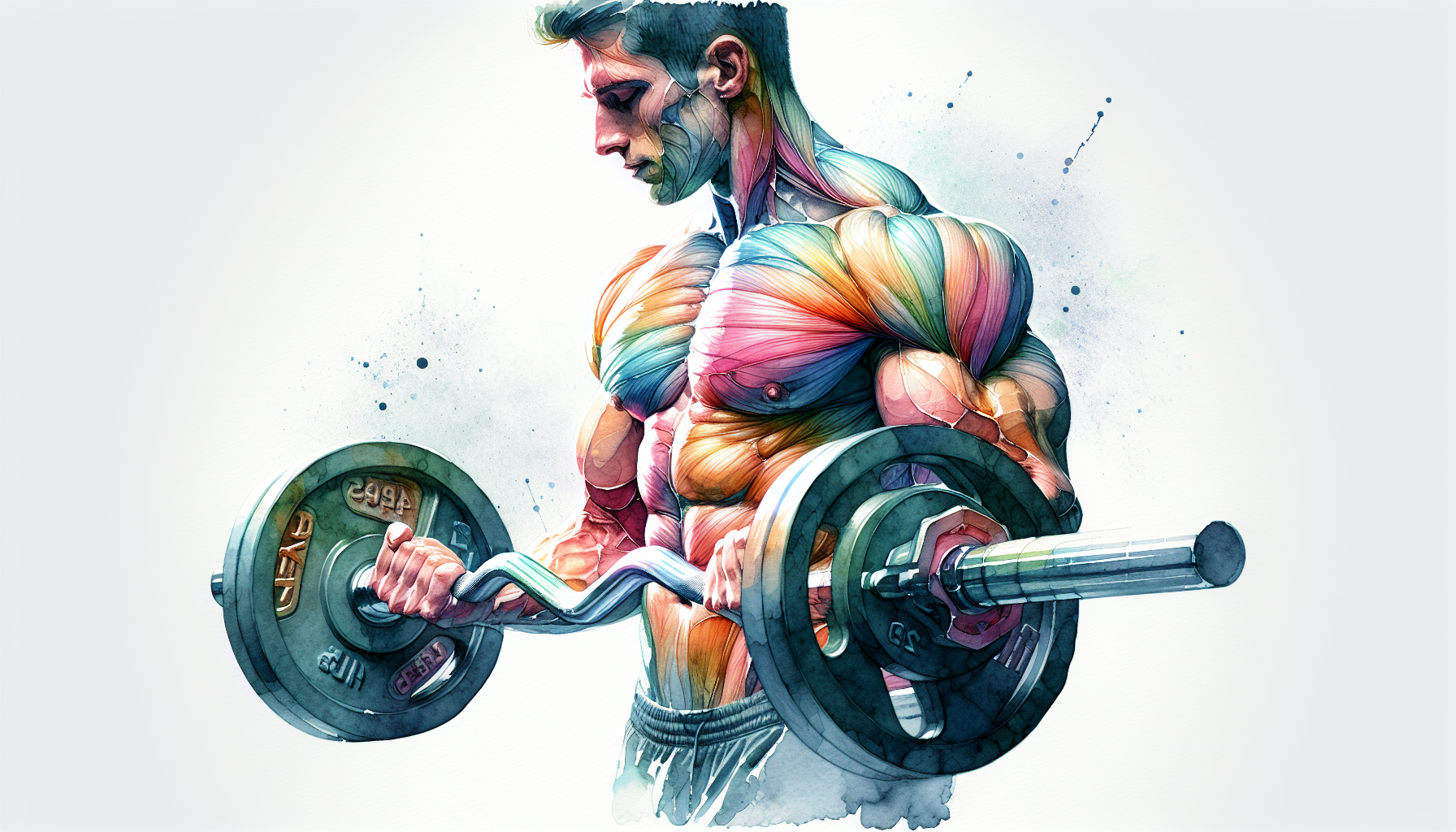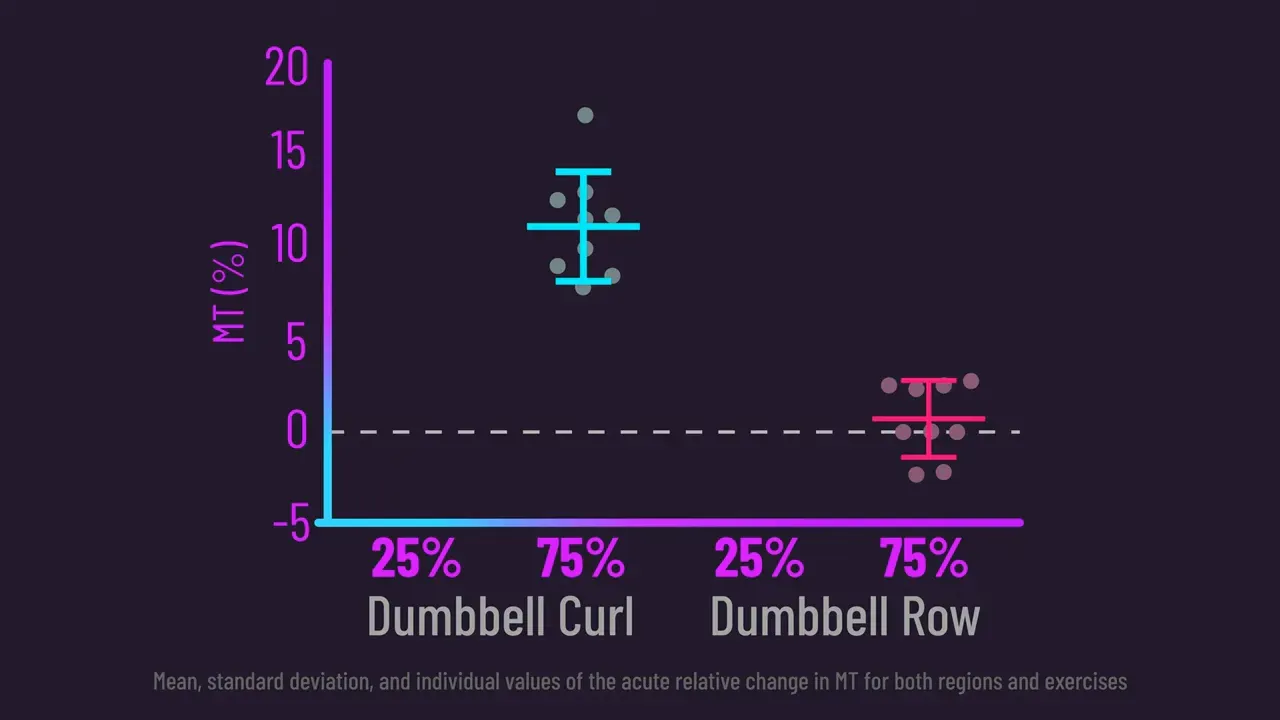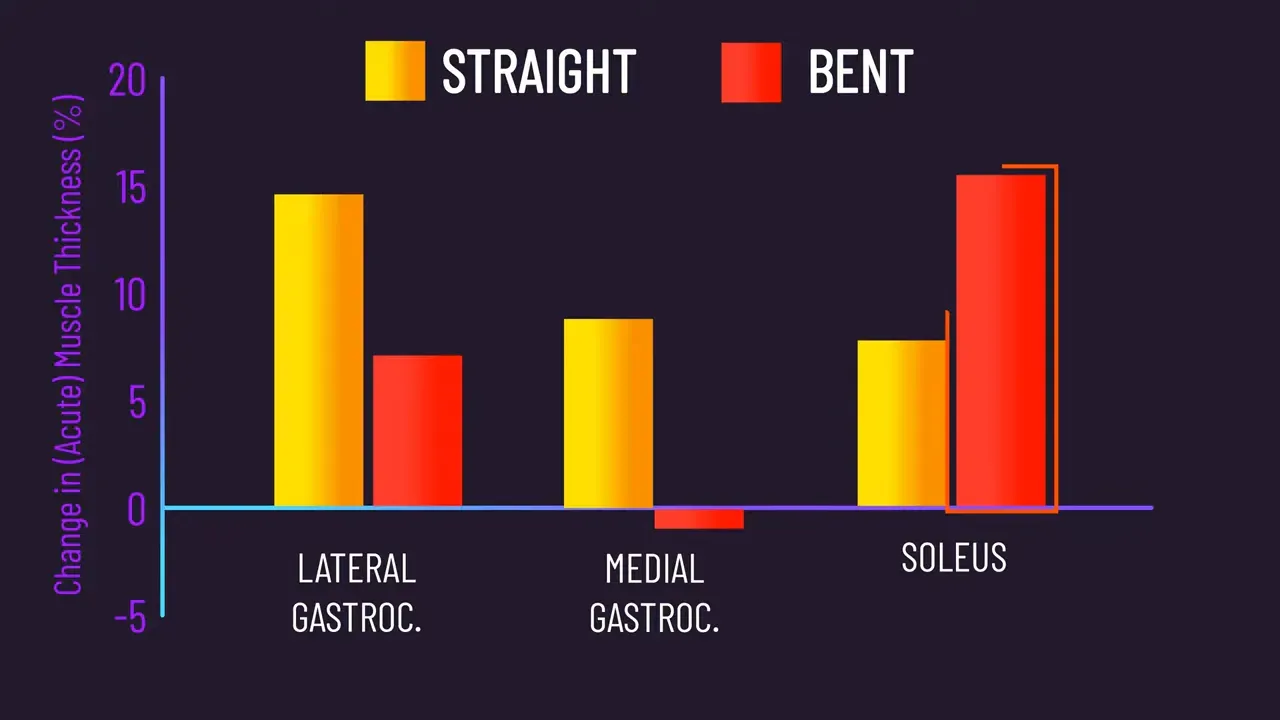Grow Bigger Arms: Scientfic Row & Curl Workout Strategies
Grow your biceps with practical, science-based methods tailored for faster gains and improved symmetry

Key Takeaways
- You can grow the lower biceps region with rows—try 2×/week for 8 weeks.
- You’ll still need curls to maximize the peak (75% region) for more size.
- You shouldn’t rely on the pump alone to predict long-term hypertrophy.
Try This Today
✔️ Pair one rowing movement and one curl in your next upper-body session. Row first, then 3–4 sets of curls to failure.
Want to build bigger arms with smarter exercise selection?
In this expert review, we analyze, critique, and expand on House of Hypertrophy's recent breakdown of a new paper that compares rows and curls for biceps and brachialis growth.
What makes this review different?
- Carefully reviewed and fact-checked by experts
- Little-known tips to apply regional hypertrophy knowledge
- Complete workout plan inspired by the study’s regional findings
Why should you listen to us? We've published 300+ articles, all rigorously reviewed by an exercise scientist with 25+ years of real-world training experience.
Keep reading to get clear, usable guidance for more muscle, less fat, and an improved physique.
Related:
- The best exercises and workouts to maximize biceps growth
- The best hypertrophy exercises and workouts for stronger, bigger arms
- Volume and muscle hypertrophy
In a Nutshell: Compound vs Isolation For Biceps Growth
You can use compound back movements to stimulate parts of your biceps and brachialis. You should still use curls to fully develop the biceps peak. Train each muscle region with enough volume—aim for progressive overload and 2–3 sessions per week.
You’ll get better overall arm size by combining rows and curls. Use rows to add volume without tiring the back too much. Use curls to prioritize the elbow flexors directly.
End on a hopeful note: a smart, simple program with both compound and isolation moves will give you measurable gains in 8–12 weeks.
Key Concepts
- Regional Hypertrophy: Different parts of a muscle may grow differently depending on the exercise.
- Acute Swelling (Pump): Short-term increases in muscle size after a set—useful but not a perfect predictor of growth.
- Volume Distribution: You can shift where volume lands via exercise choice and grip variations.
Compound Vs Isolation: Regional Biceps Growth
Study Design: Two Experiments, Two Questions
The new paper ran two experiments. Both compare a supernated dumbbell row to a supinated dumbbell curl. One focused on immediate swelling—the pump. The other tracked actual growth over 8 weeks of training. The study asks: can a compound back movement match curls for biceps and brachialis hypertrophy? And does the pump predict longer-term growth?
Experiment 1: The Pump After a Row vs. Curl
Researchers recruited 16 trained men. Each subject trained one arm with the dumbbell row and the other arm with the dumbbell curl. Both used a supinated (palms-up) grip. Each exercise was 4 sets of 8–12 reps to failure. Researchers measured muscle thickness of the elbow flexors immediately after exercise at two points along the arm: 25% and 75% of the distance from the elbow to the shoulder. That gives a regional view of swelling.
Results: the curls produced greater swelling at both regions. The difference reached statistical significance only at the 25% mark. In short: curls give a bigger, more noticeable pump—especially lower down the arm.
Experiment 2: Eight Weeks Of Training
Next, the researchers ran an 8-week training intervention. This time they used nine untrained men. Each trained one arm with rows and the other arm with curls, twice per week. Sessions had 4–6 sets per exercise, 8–12 reps to failure. Loads changed so the rep range stayed consistent. Researchers re-measured muscle thickness at the 25% and 75% points after the study.
Results were fascinating. The 75% region (closer to the elbow head/peak) grew more with curls. But the 25% region grew similarly between rows and curls. That suggests a back compound can produce comparable hypertrophy at certain biceps regions.
Interpreting The Regional Differences
Why did the 25% region respond similarly to rows and curls? Two big possibilities:
- Untrained subjects respond with broad, generalized growth. Early gains can spread across the muscle.
- Different muscles contributed unevenly. The biceps brachii and brachialis were measured together. At 25%, brachialis contribution is small; at 75% it’s bigger. This muddles interpretation.

Keep in mind: the rows were done with a supinated grip in this study. Many people row with neutral or pronated grips. Grip changes can alter elbow flexor involvement. The specific exercise selection matters.
How This Compares To Prior Studies
A 2019 study from the same group used the same design but reported only total elbow flexor growth, not regional. It showed greater whole-muscle growth from curls. The new paper adds nuance: some regions may respond similarly to compound pulls.
Earlier research from 2015 compared wide-pronated lat pulldowns to shoulder-width supinated barbell curls in 29 untrained men over 10 weeks. They found no significant difference in elbow flexor thickness at the tested region. That result surprised many. Pronated wide pulldowns working similarly to barbell curls suggests the back can tax elbow flexors enough to drive growth under certain conditions.
Practical Takeaways For Programming
- Use rows and pulldowns to contribute volume to elbow flexors. They aren’t useless for arms.
- Use curls when you want to prioritize the 75% region and maximize biceps peak.
- If you’re untrained or new to a program, compound movements can provide surprisingly broad growth.
- For advanced lifters, add isolation work to cover regions compounds miss.
Is The Pump A Good Proxy For Muscle Growth?
Definition: Pump vs. Hypertrophy
Acute swelling, the pump, is a transient increase in muscle thickness immediately after training. Hypertrophy is long-term growth measured over weeks to months. The pump feels satisfying. But does a bigger pump equal more growth?
What The Study Says
At 75%, curls produced both more swelling and more growth. That aligns pump with hypertrophy for that region. At 25%, curls produced more pump, but rows matched curls for growth. In other words: the pump and later growth did not match in all regions.
Broader Evidence On The Pump
Other research paints a mixed picture. Higher reps, drop sets, and constant-tension methods increase the pump. But they don’t always increase hypertrophy beyond traditional hypertrophy ranges. That suggests the pump alone is not the controlling factor.
Yet, training that produces a pump can still be effective for hypertrophy. The pump could contribute a small, non-dominant role, while mechanical tension and volume drive most growth. Enjoy the pump. But don’t treat it as the final arbiter.
Examples Where The Pump Matched Growth
- Flat bench press produced more mid-pec swelling than incline, and mid-pec growth tends to favor flat bench.
- Straight-leg calf raises caused more swelling of the gastrocnemii, and their growth pattern often matches that swelling.
Examples Where The Pump Didn’t Predict Growth
- Incline bench can grow the upper pec more even when pump data doesn’t clearly favor incline.
- Some curl variations change regional pump without changing long-term regional growth proportionally.
Bottom line: swelling is occasionally useful, sometimes misleading. Measure growth with reliable measures over time, not by feel alone.

Biceps-Focused Program: Rows + Curls Synthesis
This workout includes both compound rows and targeted curls. It’s based on the key insight: rows can grow lower regions of elbow flexors; curls target the peak. Use this to get more muscle and a better overall arm shape.
Program Overview
- Ideal for: Lifters wanting balanced arm growth and total volume without overtaxing the back.
- Equipment needed: Barbell, dumbbells, cable machine or pulldown, bench. Optional EZ-bar.
- Structure: Upper-body arm-focused day twice weekly or as part of a split. Use progressive overload.
Workout
Do this twice per week. Alternate emphasis across sessions (one row-focused, one curl-focused).
Day A — Row Emphasis
- Bent-Over Dumbbell Row (Supinated Grip) — 4 sets × 8–12 reps — Rest 90s
- One-Arm Dumbbell Row (Controlled) — 3 sets × 8–12 reps — Rest 75s
- EZ-Bar Curl (Strict) — 3 sets × 8–10 reps — Rest 90s
- Hammer Curl — 3 sets × 10–12 reps — Rest 60s
- Face Pulls — 3 sets × 12–15 reps — Rest 45–60s
Pro tips:
- Row first to get heavy back work in while fresh.
- Use a supinated row grip to recruit more elbow flexion.
- Keep curls strict on the first set, then slightly more tempo on later sets.
Day B — Curl Emphasis
- Barbell or Dumbbell Curls (Supinated) — 4 sets × 8–12 reps — Rest 90s
- Incline Dumbbell Curl — 3 sets × 8–12 reps — Rest 75s
- Reverse-Grip Pulldown or Pronated Pulldown — 3 sets × 8–12 reps — Rest 90s
- Concentration Curls — 2 sets × 12–15 reps — Rest 60s
- Farmer Carry (Grip & Brachialis) — 2 rounds × 40–60s — Rest 90s
Pro tips:
- Place curls earlier to prioritize mechanical tension on biceps.
- Use incline curls to target long head and the 75% region.
- Add reverse or pronated pulldowns to hit brachialis and improve arm thickness.
Notes On Program Execution
- Progressive overload: add 2–5% load or 1 rep per set each week when possible.
- Volume: aim for 9–15 weekly hard sets for elbow flexors distributed across sessions.
- Tempo: control eccentrics (2–3s) and avoid bouncing on curls.
- Recovery: ensure rest and protein intake to support hypertrophy.
Expert Corner: Proven Strategies & Hidden Gems
Practical Applications
- Combine compounds and isolations: Use rows to add elbow flexor volume without doing extra curls every session. Aim for 2–3 compound sets and 3–6 isolation sets per week as a starting split.
- Regional targeting: To favor the 75% region (biceps peak), use supinated curls and incline curls. For 25% thickness, include supinated rows and neutral-grip heavy pulls.
- Volume management: Track weekly hard sets. Start with 9–12 sets/week per muscle for untrained lifters, 12–18 for intermediates, and 18+ for advanced trainees seeking maximum growth.
- Grip variation: Rotate supinated, neutral, and pronated grips to shift emphasis between biceps and brachialis. Use pronated pulldowns and reverse curls to bias brachialis.
- Use the pump wisely: If you like the pump, use higher-rep finishing sets. But prioritize mechanical tension and progressive overload in primary sets.
Example:
- If you bench/row twice weekly, replace one direct arm day with row-focused work and two targeted curl sets after rows.
Fact-Check Of Key Points
- "Experiment one examined acute muscle swelling… straight after a row and dumbbell curl." — Accurate. The study measured immediate changes at 25% and 75% locations post-exercise.
- "Growth at the 75% region was greater with the dumbbell curls." — Accurate. The 75% region showed more hypertrophy with curls over 8 weeks.
- "Growth at the 25% region ended up being similar between both exercises." — Accurate for untrained participants in this study; generalizability to trained lifters is limited.
- "The biceps and brachialis were not separated." — Accurate. The paper reported elbow flexor thickness which includes both muscles; this reduces specificity of interpretation.
- "Swelling may be hit or miss as a proxy for hypertrophy." — Reasonable. The literature shows mixed concordance between acute swelling and long-term growth across muscles and exercises.
More Little-Known Tips For Biceps And Back Hypertrophy
- Train the elbow flexors from multiple lengths. Use incline curls to lengthen the biceps; use preacher or spider curls to emphasize mid-range peak tension.
- Use reverse-grip pulldowns or rows occasionally to overload the brachialis and add arm thickness.
- When fatigued, switch to single-arm work to maintain volume without compromising technique.
- Periodize volume: cycle high-volume phases with lower-volume strength phases every 4–8 weeks.
Common Mistakes With Biceps Training & How To Fix Them
- Over-relying on the pump: Fix by tracking progressive overload and weekly sets, not how full your arms feel after a set.
- Always doing the same curl: Fix by rotating standing barbell curls, incline curls, hammer curls, and preacher curls every 4–6 weeks.
- Neglecting back compounds: Fix by adding 2–4 heavy pulling sets before isolation for better overall volume and posture.
- Using momentum on curls: Fix by reducing load and focusing on controlled eccentrics and strict form.
Science of Arm and Biceps Training for Hypertrophy
Research on resistance training shows that the arms, including the biceps and triceps, grow best when training volume, load, and effort are balanced. Reviews and meta-analyses consistently suggest that multiple training approaches can be effective, but volume and consistency are the main drivers of hypertrophy.
Key Findings from Reviews and Meta-Analyses
- Weekly volume matters: Performing at least 10–20 sets per muscle group per week is optimal for hypertrophy, with higher volumes (closer to 20) possibly offering extra benefit for triceps compared to biceps (Bernárdez-Vázquez et al., 2022); (Baz-Valle et al., 2022).
- Load flexibility: Both heavy (≥80% 1RM) and lighter (<80% 1RM) weights can build arm muscle, as long as multiple sets are performed to near failure (McLeod et al., 2023); (Carvalho et al., 2022).
- Failure vs. non-failure: Training to muscular failure is not required, though it may provide a small benefit for hypertrophy in trained lifters (Grgic et al., 2021).
- Advanced methods: Techniques like blood flow restriction (BFR) training with light loads can induce hypertrophy in the biceps similar to heavy lifting, which may be useful for those with joint issues (Sugiarto et al., 2017).
- Population differences: Both men and women, including older adults, can achieve significant arm hypertrophy with properly structured resistance training (Nunes et al., 2024); (Gotshalk et al., 1999).
Practical Applications of Science
- Aim for 12–20 weekly sets per muscle group for arms (biceps and triceps).
- Use both heavy and light weights, ensuring sets are challenging and close to failure.
- Consider BFR training as an alternative or supplement, especially during rehab or joint stress periods.
Scientific Conclusion
Biceps and triceps hypertrophy responds best to moderate-to-high training volumes performed consistently, with flexibility in load and effort. Multiple approaches are effective, but sufficient weekly volume is the most critical driver of arm muscle growth.
My Opinion On Compound Exercises For The Biceps
I like compound exercises. They give you extra work and train several muscles at once. That helps you add total volume without endless isolation work.
I also believe in targeted isolation. Curls give you the direct mechanical tension that the biceps need to build the peak and specific regions. If you want maximal biceps shape, you must include curls.
I disagree with the blanket claim that compounds alone will always suffice for biceps hypertrophy. For beginners, compounds can be enough for sizeable gains. For intermediate and advanced lifters chasing small increments of improvement, targeted curls remain indispensable.
I accept that rows and pulldowns can grow elbow flexors. But I caution you: grip, technique, and prior training status change the outcome. Don’t assume your rows will grow your biceps the same way as curls if you are an experienced lifter chasing symmetry and peak development.
Concluding On Compound Vs Isolation For The Biceps
A compound movement can contribute substantially to elbow flexor growth. The new study shows rows can match curls at lower arm regions in untrained men over eight weeks. But curls still win at growing the 75% region, the area most related to biceps peak.
That means you don’t have to do endless curls to build decent arms—rows carry a meaningful load. But if you want the peak, you must add curls. Combine both for balanced growth and better results: more muscle, less fat, improved physique.
Want to automate this process and get a program that adjusts as you progress? Put your progress on autopilot with Dr. Muscle AI. Try it free.
FAQ
Are Compound Exercises Enough For Biceps?
Compound exercises can be enough for early biceps growth. They stimulate the elbow flexors and allow you to accumulate volume. However, to maximize biceps peak and specific regional growth, you should include targeted curls.
Does The Pump Predict Muscle Hypertrophy?
The pump is a short-term increase in muscle size due to swelling. It sometimes aligns with long-term growth, but not always. Use progressive overload and weekly hard-set counts to judge hypertrophy, not pump alone.
How Often Should You Train Biceps For Hypertrophy?
You should aim for 2–3 sessions per week that include both direct and indirect work. Accumulate about 9–18 hard sets per week for the elbow flexors depending on your experience and recovery.
Which Grip Is Best For Biceps Peak?
Supinated grips and incline curls favor the long head and the 75% region associated with biceps peak. Vary grips to hit different regions and include hammer/reverse grips for brachialis development.
Can Rows Replace Curls In A Program?
Rows can replace some curling volume, especially for lower arm thickness. But they won’t fully replace curls if your goal is maximal biceps peak. Use rows as part of a combined plan.
How Long Until I See Arm Growth?
Untrained lifters can see visible changes in 6–12 weeks with consistent training and nutrition. Regional preferences may take longer; track progress with measurements or photos rather than relying on the pump.
Final note
Compound lifts add valuable elbow flexor volume. Curls polish the peak. To automate your progress and get a smart, adaptable plan that blends both, check Dr. Muscle AI. Try it free.
We used AI to summarize the video “Compound Exercises Are Enough for the Biceps” (New Study) while drafting this expert review.

